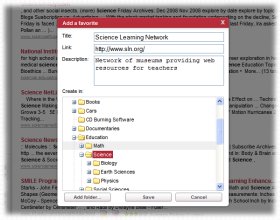|
Education
Web
Child & Adult Care Food Program (CACFP)
adult day health care, and Alzheimer's resource centers. Child Care Component Resources and information regarding child care agency participation in the federal CACFP, including a segment on sponsors who administer the program in independent child care centers and day care hom...
Electric and Magnetic Fields (EMF)
Bayesian philosophy of science. Public comments and criticisms of this report are posted on the same website. The California EMF Program also published Policy Options in the Face of Possible Risk from Power Frequency Electric and Magnetic Fields (EMF) [PDF - 76 KB]...
Science Podcast: Accurate Automatic Face Recognition; Complete Synthesis of a Genome; Unde...
facial recognition to 100% by using what they call an "averaged" face. In the future, it could mean a new kind of photo for your passport. I spoke to Jenkins from his office at the University of Glasgow. Interviewee - Rob Jenkins As you know, there&rsqu...
1
0
facial recognition to 100% by using what they call an "averaged" face. In the future, it could mean a new kind of photo for your passport. I spoke to Jenkins from his office at the University of Glasgow. Interviewee - Rob Jenkins As you know, there’s increasing interest in security applications and security infrastructure and biometrics in general. The problem is, a lot of the face recognition systems that are out there simply don’t work at anything like the level that people think they do. So for some
1
0
http://www.sciencemag.org/cgi/data/319/5862/499b/DC1/1#page=7
www.sciencemag.org/cgi/data/319/5862/499b/DC1/1#page=7
facial <span class="highlight">recognition</span> to 100% by using what they call an "averaged" <span class="highlight">face</span>. In the future, it could mean a new kind <span class="highlight">of</span> photo <span class="highlight">for</span> your passport. I spoke to Jenkins from his office at the University <span class="highlight">of</span> Glasgow. Interviewee - Rob Jenkins As you know, there’s increasing interest in security applications and security infrastructure and biometrics in general. The problem is, a lot <span class="highlight">of</span> the <span class="highlight">face</span> <span class="highlight">recognition</span> systems that are out there simply don’t work at anything like the level that people think they do. So <span class="highlight">for</span> some
2
0
http://www.sciencemag.org/cgi/data/319/5862/499b/DC1/1#page=8
www.sciencemag.org/cgi/data/319/5862/499b/DC1/1#page=8
we realized that we could exploit this setup to try to get at the performance level <span class="highlight">of</span> that <span class="highlight">face</span> <span class="highlight">recognition</span> system on images <span class="highlight">of</span> real world variability. So these are images that contain all the variability in lighting and so on that we are used to dealing with in the real world. But it’s exactly that <span class="highlight">information</span> that usually trips up the automatic systems. And so the logic behind this was that if the system is performing well, and we feed it a photograph <span class="highlight">of</span> Bill Clinton, it should tell us that the closest
Sonoma State University: Alphabetic Principle
Explain how readers use a variety of strategies for decoding words, including phonic analysis, onset-rime, structural analysis, syllabication, automatic word recognition, and syntax and semantics. Summarize the difficulties students with learning/reading disabilit...
Scholastic: Saluting Tech-Savvy Districts
Saluting Tech-Savvy Districts | Scholastic.com Administrator Magazine Scholastic Administrator is a must-read resource for 240,000 of today's results-driven school leaders. Every issue features leadership for education executives, insight and analysis into what's next i...
Stony Brook: What is a System of Linear Equations?
Graphs Nicely Drawing Trees Planarity Detection and Embedding 1.5 Graph Problems -- hard problems Clique Independent Set Vertex Cover Traveling Salesman Problem Hamiltonian Cycle Graph Partition Vertex Coloring Edge Coloring Graph Isomorphism Steiner Tree Feedback Edge/Vertex...
Reading Word Analysis Apply knowledge of cognates and false cognates to derive meaning from literature and texts in content areas. Grade Two 1.1 Recognize and use knowl edge of spelling patterns (e.g., diphthongs, special vowel spellings) when reading. 1.2 Apply kno...
1
0
Reading Word Analysis Apply knowledge of cognates and false cognates to derive meaning from literature and texts in content areas. Grade Two 1.1 Recognize and use knowl edge of spelling patterns (e.g., diphthongs, special vowel spellings) when reading. 1.2 Apply knowledge of basic syllabication rules when reading (e.g., vowel-consonant-vowel = su/per; vowel-consonant/ consonant-vowel = sup/per). 1.3 Decode two-syllable nonsense words and regular multisyllable words. 1.4 Recognize
39
0
http://www.cde.ca.gov/re/pn/fd/documents/englangdev-stnd.pdf#page=39
www.cde.ca.gov/re/pn/fd/documents/englangdev-stnd.pdf#page=39
Reading Word <span class="highlight">Analysis</span> Apply knowledge <span class="highlight">of</span> cognates and false cognates to derive meaning from literature and texts in content areas. Grade Two 1.1 Recognize and use knowl­ <span class="highlight">edge</span> <span class="highlight">of</span> spelling patterns (e.g., diphthongs, special vowel spellings) when reading. 1.2 Apply knowledge <span class="highlight">of</span> basic syllabication rules when reading (e.g., vowel-consonant-vowel = su/per; vowel-consonant/ consonant-vowel = sup/per). 1.3 Decode two-syllable nonsense words and regular multisyllable words. 1.4 Recognize
63
0
http://www.cde.ca.gov/re/pn/fd/documents/englangdev-stnd.pdf#page=63
www.cde.ca.gov/re/pn/fd/documents/englangdev-stnd.pdf#page=63
READING Literary Response and <span class="highlight">Analysis</span> <span class="highlight">For</span> English learners to improve their English skills and reduce the likelihood that those skills will level off before the students reach fluency, they need to learn academic content along with language skills. Instruc­ tion in academic areas, such as literature, mathematics, geography, history, govern­ ment, and science, not only familiarizes learners with the content <span class="highlight">of</span> the discipline, but also, what is more important, teaches them how to use the language
Is the Price of Gasoline Really Too High?
select a cost component to investigate. This investigation will send each of you to several different web sites where you will gather the information necessary to determine if the market for gasoline is competitive. You will also meet with the other team members in th...
Student Portfolios as Visual Organizers for Journey North
cycle information, characteristics, and migration maps Drawings, diagrams, charts, graphs, and analysis of data Concept maps or KWL charts Initial predictions and revised predictions along with explanations for revisions Calculations and "worksheets" Compact i...
Quality in Distance Education. ERIC Digest.
education today." Dziuban and Moskal (2001) found that courses with both a web and face-to-face component produced the same or better success rates than courses that were fully online or face-to-face. This result teases us into asking whether there is some opt...
|
